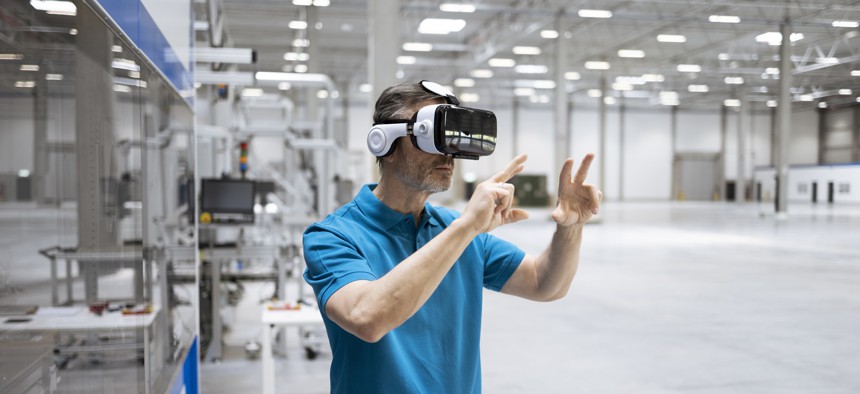Virtual reality, location services get workout at responder test lab

GettyImages/Westend61
At the Public Safety Immersive Test Center, researchers can test whether their user interfaces and indoor location tracking services work as expected.
Researchers at the new Public Safety Immersive Test Center (PSITC) are putting location-based services (LBS) and user interface/user experience (UI/UX) technologies through their paces as they work on infrastructure-free systems first responders can use indoors.
Launched in May, PSITC is a joint effort of the National Institute of Standards and Technology (NIST) and the First Responder Network Authority (FirstNet). The 1,000-plus square feet center is modular so that researchers can build different scenarios, and it’s outfitted with a motion capture system, 42 high-speed optical tracking cameras, augmented and virtual reality (VR) headsets, and other gear pertinent to simulations for fire, police and emergency medical service personnel.
“The thing that makes PSITC so powerful as a tool for both the LBS research we’re doing at [NIST Public Safety Communications Research] and the UI/UX research is a system we have there called an OptiTrack motion capture system,” said Joe Grasso, who leads PSCR’s LBS portfolio. The system can track 1,500 markers simultaneously down to a centimeter, he added.
GPS is great outside, but it doesn’t work inside buildings. There are systems that can track responder locations indoors, but they require infrastructure that can’t easily or safely be used during emergencies, Grasso said.
“If you wanted to track something indoors today, you’d probably want to install all sorts of sensors or transmitters inside of a building, and that can be really expensive and just not practical in terms of trying to outfit an entire response area with sensors,” he said. “Since this [study at PSITC] involved those 42 cameras that are mounted on the ceiling, this is not the solution for public safety to use while tracking themselves while indoors. This is a great tool for determining whether the systems that do get created are doing an accurate job of tracking folks.”
Grasso works closely with Scott Ledgerwood, lead of PSCR’s UI/UX portfolio, who has been using virtual reality to assess the usability of various technologies for public safety operations and training.
“It’s a relatively safe and low-cost approach for conducting some of these exercises,” Ledgerwood said. “We don’t have to do a controlled burn, we don’t have to have a mock HAZMAT spill for supporting these activities. We can essentially curate these environments from the ground up using our in-house team and then turn this over to the community to allow for prototyping future user interfaces like heads-up displays or haptic feedback-type systems or even audio cues or vocal interactions,” he said. “Because we essentially control every aspect of it, we can instrument it with metrics so we that we can actually assess that usability of that technology intervention.”
Rather than using handheld controllers to navigate simulated environments, which can limit the seamlessness between digital and real environments, testers wear gloves, and the team has mapped walls, chairs and other elements one-to-one with the VR setting so that when a user touches something, it’s really there.
“If we want a firefighter to come in here and assess a potential user interface, they could be in full personal protective equipment if they like, they can don the headset and they can crawl through the environment, they can interact with the furniture, they can interact with props like the victims in this space or fire nozzles in this space that are tracked,” Ledgerwood said, adding that the team plans to add another 20 cameras to the perimeter to improve the validity of assessments.
The lab invites stakeholders – namely, public safety officials – to try the technologies.
“They are on the extreme cutting edge of communications technology and how that works with public safety,” said Sterling Folden, deputy chief of Mountain View Fire and Rescue in Longmont, Colorado, who has visited the facility.
It’s also changing how responders get pitched new technologies. Traditionally, sales reps would approach him with their offerings, Folden said. “It’s almost flip-flopped. They’re not telling us why we need it. We’re telling them why we need it and then they develop it,” he said.
The facility is not open to just anyone to use, however, said Dereck Orr, director of PSCR. It’s dedicated to specific research portfolios and recruits subject-matter experts to come in and assist with testing.
“We look five, 10, 15 years out on what’s that future use case for FirstNet and how do we start to drive the momentum in that direction,” Orr said.
A technology that PSITC has its eye on is high-speed networking.
“One of the things that we’re looking at, at the Public Safety Immersive Test Center is this integration with Wi-Fi or 5G – these broadband technologies that are going to allow us to do things in the future like mobile edge compute, where we can do a lot of this rendering offline or at the edge and deliver it to lightweight devices,” Ledgerwood said.
In 2012, the Middle Class Tax Relief and Job Creation Act directed $300 million to NIST to develop future-focused research and development for public safety, and that money runs out on Sept. 30, Orr said. But NIST is supporting the continuation of several PSCR portfolios, including LBS and UI/UX.
Stephanie Kanowitz is a freelance writer based in northern Virginia.
NEXT STORY: Video games can change your brain for the better





